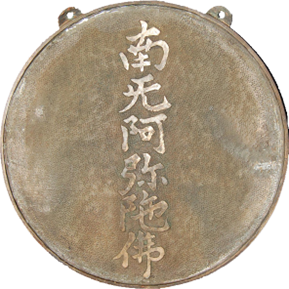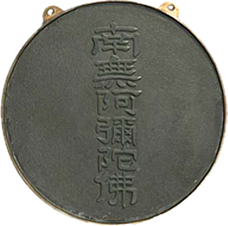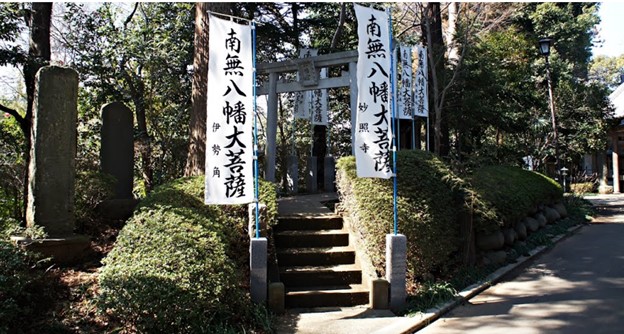Kanji Question from Kamakura
Mark Schumacher
Hi PMJS Members
As always, I am confused.
When comparing magic mirrors 魔鏡 from the Edo
period,
I run across three variations in Amida's Nenbutsu 念佛.
旡 ・ 无 ・ 無 (how about 𣠮?). Do they
all mean the same thing? Why the difference?
See examples below.



|
MARK SCHUMACHER |
Michael Jamentz
--
PMJS is a forum dedicated to the study of premodern Japan.
To post to the list, email pm...@googlegroups.com
For the PMJS Terms of Use and more resources, please visit www.pmjs.org.
Contact the moderation team at mod...@pmjs.org
---
You received this message because you are subscribed to the Google Groups "PMJS: Listserv" group.
To unsubscribe from this group and stop receiving emails from it, send an email to pmjs+uns...@googlegroups.com.
To view this discussion on the web visit https://groups.google.com/d/msgid/pmjs/c03ffb67-1381-1a4e-bf2d-be077df1356b%40onmarkproductions.com.
Brian Ruppert
--
PMJS is a forum dedicated to the study of premodern Japan.
To post to the list, email pm...@googlegroups.com
For the PMJS Terms of Use and more resources, please visit www.pmjs.org.
Contact the moderation team at mod...@pmjs.org
---
You received this message because you are subscribed to the Google Groups "PMJS: Listserv" group.
To unsubscribe from this group and stop receiving emails from it, send an email to pmjs+uns...@googlegroups.com.
To view this discussion on the web visit https://groups.google.com/d/msgid/pmjs/c03ffb67-1381-1a4e-bf2d-be077df1356b%40onmarkproductions.com.
Lisa Kochinski
--
PMJS is a forum dedicated to the study of premodern Japan.
To post to the list, email pm...@googlegroups.com
For the PMJS Terms of Use and more resources, please visit www.pmjs.org.
Contact the moderation team at mod...@pmjs.org
---
You received this message because you are subscribed to the Google Groups "PMJS: Listserv" group.
To unsubscribe from this group and stop receiving emails from it, send an email to pmjs+uns...@googlegroups.com.
To view this discussion on the web visit https://groups.google.com/d/msgid/pmjs/c03ffb67-1381-1a4e-bf2d-be077df1356b%40onmarkproductions.com.
携帯電話から送信
Sent from my mobile
Lisa Kochinski
Cynthea Bogel

On Jul 23, 2022, at 11:28 PM, Michael Jamentz <meja...@gmail.com> wrote:
Hello Mark et al.I recommend the glypwiki site. You can see many alternative characters for 無, including the ones you mention.I don't know why anyone would choose other characters, except for obvious ease in producing the simpler versions.Best,m jamentz
On Sun, Jul 24, 2022 at 12:15 PM Mark Schumacher <m...@onmarkproductions.com> wrote:
Hi PMJS Members
As always, I am confused.
When comparing magic mirrors 魔鏡 from the Edo period,
I run across three variations in Amida's Nenbutsu 念佛.
旡 ・ 无 ・ 無 (how about 𣠮?). Do they all mean the same thing? Why the difference?
See examples below.
<Fsp1L5iFkEV6K03x.png><auZz3oP8QObXLdEr.png><Dnu1vcxY0TF9tiga.png>
--
MARK SCHUMACHER
Tel/Fax: 0467-67-5005 (in Japan) and 81-467-67-5005 (outside Japan)
https://www.onmarkproductions.com/html/buddhism.shtml

--
PMJS is a forum dedicated to the study of premodern Japan.
To post to the list, email pm...@googlegroups.com
For the PMJS Terms of Use and more resources, please visit www.pmjs.org.
Contact the moderation team at mod...@pmjs.org
---
You received this message because you are subscribed to the Google Groups "PMJS: Listserv" group.
To unsubscribe from this group and stop receiving emails from it, send an email to pmjs+uns...@googlegroups.com.
To view this discussion on the web visit https://groups.google.com/d/msgid/pmjs/c03ffb67-1381-1a4e-bf2d-be077df1356b%40onmarkproductions.com.
--
PMJS is a forum dedicated to the study of premodern Japan.
To post to the list, email pm...@googlegroups.com
For the PMJS Terms of Use and more resources, please visit www.pmjs.org.
Contact the moderation team at mod...@pmjs.org
---
You received this message because you are subscribed to the Google Groups "PMJS: Listserv" group.
To unsubscribe from this group and stop receiving emails from it, send an email to pmjs+uns...@googlegroups.com.
To view this discussion on the web visit https://groups.google.com/d/msgid/pmjs/CAEu_BgdH%2BmDacSVPZom94Z9HDYfVdAFEM9FUxzoduodjEZpRmg%40mail.gmail.com.
Kazuhiro Okada
I’d love to add one thing that 旡 is not same as 无, one of the variants of 無, but easily confusable with that.
𣠮 is a reconstructed variant of 無 from the Shuowen Jiezi Seal Script graph.
See the database entries below for other examples:
https://www.chise.org/est/view/character/%E6%97%A0
https://search.hng-data.org/search/%E7%84%A1
Best regards,
--
Kazuhiro Okada
oo....@gmail.com
> 2022/07/24 14:15、Lisa Kochinski <lis...@gmail.com>のメール:
> Hello again Mark,
>
> To continue the discussion, there are many different ways of rendering the sounds of the two characters in namu. In the 南無 entry in the Digital Dictionary of Buddhism, Charles Muller lists: 南牟; 南謨; 南忙; 那謨, 那模, 那麻, 納莫, 納慕; 娜母; 曩莫, 曩謨, 捺麻, 捺謨, etc.
>
> Best regards,
> Lisa Kochinski
> PhD Candidate (ABD)
> University of Southern California
>
> On Sat, Jul 23, 2022 at 22:01 Lisa Kochinski <lis...@gmail.com> wrote:
> Hi Mark,
>
> The reading for 无 is mu, so 南无 reads namu. 旡 Is an alternate form of 无, so 南旡 also reads namu.
>
> Hope you are doing well in Kamakura!
>
> Best regards,
> Lisa
>
> On Sat, Jul 23, 2022 at 20:15 Mark Schumacher <m...@onmarkproductions.com> wrote:
> Hi PMJS Members
>
> As always, I am confused.
>
> When comparing magic mirrors 魔鏡 from the Edo period,
>
> I run across three variations in Amida's Nenbutsu 念佛.
>
> 旡 ・ 无 ・ 無 (how about 𣠮?). Do they all mean the same thing? Why the difference?
>
> See examples below.
>
>
>
> --
> MARK SCHUMACHER
> Tel/Fax: 0467-67-5005 (in Japan) and 81-467-67-5005 (outside Japan)
> https://www.onmarkproductions.com/html/buddhism.shtml
>
>
Mark Schumacher
Just learned that “Namo Amida Butsu" 南无阿弥陀佛 (Hail Amida Buddha) is a particular spelling / pronunciation unique to the Nishi Honganji 西本願寺派 sect of New Pure Land Buddhism 浄土真宗.
南無阿弥陀佛
南無阿彌陀佛
南旡阿弥陀佛
南无阿弥陀佛
南元阿弥陀佛
Trad. | Simple
彌 → 弥
無 → 旡
無 → 无
無 → 元
無 → 𣠮
So much to learn, so little time.
As the Germans say: "Too soon old, too late smart."
rock on, mark in kamakura

To view this discussion on the web visit https://groups.google.com/d/msgid/pmjs/CAKi0wioC8OEifT48Q0pgj-8DERqqUQdqwGtZEcLetw83QQC-gg%40mail.gmail.com.
Raji Steineck
Gesendet: Sonntag, 24. Juli 2022 07:15
An: pm...@googlegroups.com <pm...@googlegroups.com>
Betreff: Re: [PMJS] Kanji Question from Kamakura
Pinnington, Noel J - (noelp)
On Jul 23, 2022, at 22:45, Cynthea Bogel <cjb...@gmail.com> wrote:
External Email
To view this discussion on the web visit https://groups.google.com/d/msgid/pmjs/80A4111E-ADA0-4865-BB8B-2D1B5BF591CD%40gmail.com.
Mark Blum
To view this discussion on the web visit https://groups.google.com/d/msgid/pmjs/ZRAP278MB0739EEC0C4F364977E23E6D9C7929%40ZRAP278MB0739.CHEP278.PROD.OUTLOOK.COM.
Ross Bender

